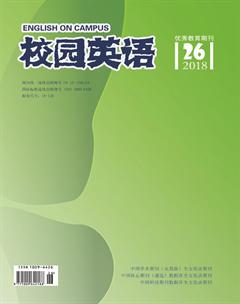On Translation Strategies adopted in The Golden Cangue
【Abstract】The Golden Cangue was Eileen Changs self-translation work. On analyzing the translation strategy, it can be found that literal translation and free translation are used the most frequently in translating this novel. Transliteration, and addition also have been used.
【Key words】The Golden Cangue; translation strategies
【作者简介】张树梅,辽宁大学。
The Golden Cangue is the masterpiece of Eileen Chang, which was translated from Chinese into English by herself, using many different translation strategies. Fu lei has ever commented that “There was no doubt that The Golden Cangue was the finest work by Miss Chang up to now... At least, it was one of the most beautiful works in our literal world” (qtd. in Wu 15).
1. Transliteration
In The Golden Cangue, Eileen Chang employed transliteration in translating to make her readers fully understand the text and Chinese culture.
(1)帐檐上垂下五彩攒金绕绒花球,花盆,如意,粽子……(Zhi 248)
...toy flower pots, yu-yi, and rice dumplings... (Chang 216)
(2)在麻将桌上……将儿子亲口招供的她媳妇的秘密宣布了出来……(Zhi 254)
Over the mahjong table she told the detail all her daughter-in-laws secrets as confessed by her son...(Chang 237)
In example (1), since “如意” does not exist in the western country, it is hard for western people to comprehend this word. Chang transliterated “如意” into “yu-yi”, so that it can be easily understood. In example (2), it is uncontroversial that mahjong was invented by Han people to play as a game, which is invented in the specific time and area. Transliteration is adopted by Eileen Chang to preserve the original flavor.
2. Literal Translation
Literal translation focuses on faithfulness to the source text and pays much attention to realize a naturally reading target language texts rather than preserving the source language texts grammar and syntax unbroken.
(3)她把兩手抄在青莲色旧绸夹袄里…(Zhi 220)
She puts her both hands under her old lined jacket of dark violet silk…(Chang 172)
(4)佛青袄子上沾了大块的淡色的灰。(Zhi 227)
Her Buddha-blue jacket was smudged with patches of pale chalk.(Chang 213)
(5) ……她藏青长袖旗袍上有着浅黄的雏菊。(Zhi 223)
... light yellow daisies on her navy blue long-sleeved gown. (Chang 273)
From the example (3), (4) and (5), on doing with color word “青(qing)”, Chang respectively used the words “violet, blue, navy”, which are well-known by western people.
3. Free Translation
The definition of free translation is “a supplementary means to mainly convey the meaning and spirit of the original without trying to reproduce its sentence patterns of figures of speech” (qtd. in Dai 38). Namely, translators need to translate the source texts to target texts according to his / her comprehension to the work, concerning expressing custom of the two language communities. Following examples reflect Eileen Changs success in culture-loaded words translation by using free translation.
(6)……拎着四只提篮盒 (Zhi 262)
...carrying food in a two-decked set of round wooden boxes. (Chang 188)
(7)卖豆腐花的挑着担子悠悠吆喝着……(Zhi 264)
The bean-curd soup vender with the flat pole on his shoulder…(Chang 176)
In example (6) and (7), “提篮盒” and “豆腐花” are typical tools of delivering foods and special food in China. By free translation, Chang describes the structures and features of the tool so as to convey meaning in the original text, and translates the food into “bean-curd soup”, which is easy for the readers to understand.
4. Addition
Addition means to add necessary words in translation to make the target text grammatically correct, semantically clear, logically acceptable, and culturally appropriate. In Chinese, people often omit subject when speaking. In The Golden Cangue, missing of subject is very common. Eileen Chang added the subject in her translation to make the context meaningful and coherent.
(8)小雙笑道:“……给什么穿什么——一个个打扮得庄稼人似的!” (Zhi 234)
… “... We wear whats given us——all dressed like peasants ” (Chang 139)
(9) 玳珍道:“想是有两句私房话要说。”(Zhi 224)
Tai-chen said, “I suppose she has a few words to say in private.” (Chang 146)
Judging from the example (8) and (9), subject “we” and “I” and subject to the objective clause “she” are all omitted in Chinese. Eileen Chang added them in translation, making the target text meaningful, coherent and faithful to the source text.
References:
[1]Chang,Eileen.The Golden Cangue.Columbia University Press,1971.

